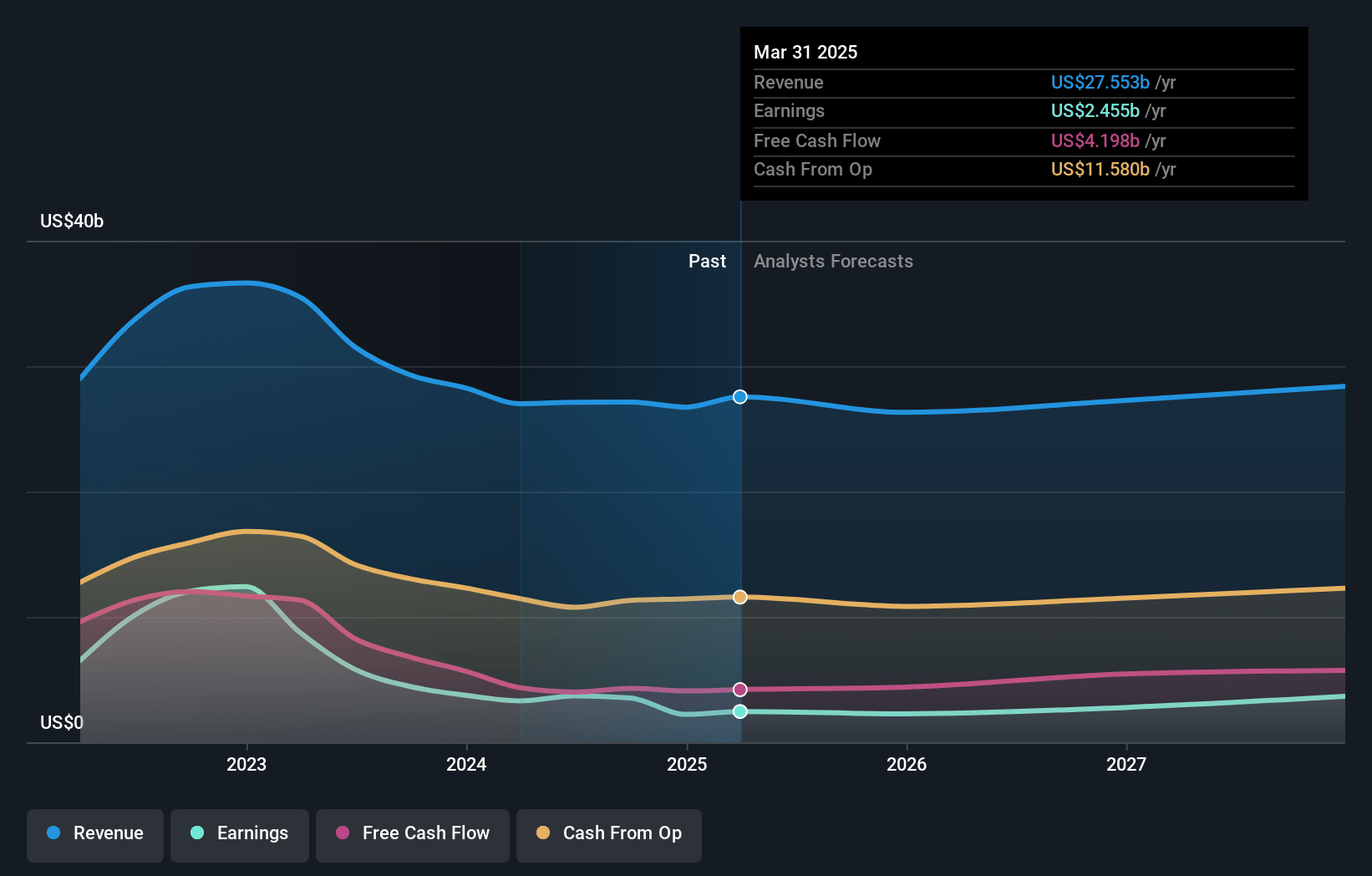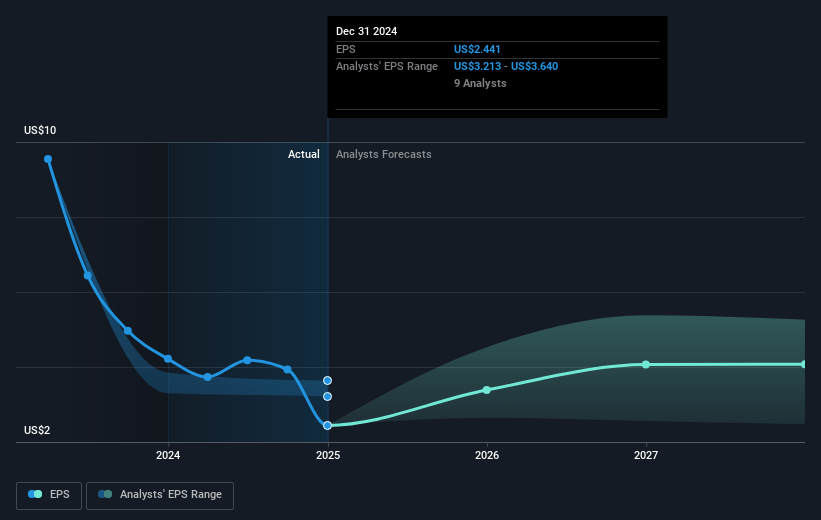Key Takeaways
- Strategies to optimize production costs and enhance operational efficiencies are likely to improve Occidental's net margins and profitability.
- Advancements in carbon management technologies could position Occidental as a leader, offering new revenue streams and cost savings.
- Challenges with cost, scalability, and regulatory support for environmental projects may affect Occidental's capital expenditure, cash flow, and long-term profitability.
Catalysts
About Occidental Petroleum- Engages in the acquisition, exploration, and development of oil and gas properties in the United States and internationally.
- Occidental Petroleum's commitment to growth in short-cycle, high-return assets and the execution of major projects such as STRATOS is expected to enhance future cash flows and revenue as these projects come online.
- The strategy to replace higher-cost production with a larger volume of lower-cost new reserves will likely improve the company's net margins, as it reduces production costs and increases efficiency.
- Occidental's advancements in carbon capture and Direct Air Capture (DAC) technologies, including the construction of DAC facilities and foundational Carbon Dioxide Removal agreements, could position the company as a leader in carbon management, providing a new revenue stream and potential cost savings on carbon credits.
- The planned reduction of per-unit lease operating expenses and well costs by leveraging operational efficiencies suggests future growth in net margins, as these efforts reduce overall expenditure and enhance profitability.
- The anticipated depreciation in royalties and higher sulfur pricing for Al Hosn production, alongside continued focus on output maximization through advanced technology, might favorably impact earnings and indicate further margin stabilization.
Occidental Petroleum Future Earnings and Revenue Growth
Assumptions
How have these above catalysts been quantified?- This narrative explores a more pessimistic perspective on Occidental Petroleum compared to the consensus, based on a Fair Value that aligns with the bearish cohort of analysts.
- The bearish analysts are assuming Occidental Petroleum's revenue will decrease by 0.3% annually over the next 3 years.
- The bearish analysts assume that profit margins will shrink from 8.3% today to 5.5% in 3 years time.
- The bearish analysts expect earnings to reach $1.4 billion (and earnings per share of $2.2) by about April 2028, down from $2.2 billion today. The analysts are largely in agreement about this estimate.
- In order for the above numbers to justify the price target of the more bearish analyst cohort, the company would need to trade at a PE ratio of 48.7x on those 2028 earnings, up from 16.6x today. This future PE is greater than the current PE for the US Oil and Gas industry at 11.1x.
- Analysts expect the number of shares outstanding to grow by 5.85% per year for the next 3 years.
- To value all of this in today's terms, we will use a discount rate of 7.83%, as per the Simply Wall St company report.
Occidental Petroleum Future Earnings Per Share Growth
Risks
What could happen that would invalidate this narrative?- Occidental Petroleum is facing potential challenges with its direct air capture technology's cost and scalability, which could impact future capital expenditure requirements and earnings.
- The company's significant reliance on U.S. onshore assets may expose it to commodity price fluctuations, affecting revenue and cash flow.
- Uncertainty around regulatory support for carbon capture initiatives, particularly changes with the U.S. administration, could affect Occidental's planned environmental projects and overall cash flows.
- The company's heavy capital investments in projects like STRATOS and the battleground modernization may not yield expected returns, impacting long-term margins and profitability.
- The recent unfavorable Federal Court ruling related to environmental remediation liabilities creates financial risk, potentially increasing long-term liabilities and negatively affecting net income and earnings.
Valuation
How have all the factors above been brought together to estimate a fair value?- The assumed bearish price target for Occidental Petroleum is $48.48, which represents one standard deviation below the consensus price target of $55.12. This valuation is based on what can be assumed as the expectations of Occidental Petroleum's future earnings growth, profit margins and other risk factors from analysts on the more bearish end of the spectrum.
- However, there is a degree of disagreement amongst analysts, with the most bullish reporting a price target of $68.0, and the most bearish reporting a price target of just $40.0.
- In order for you to agree with the bearish analysts, you'd need to believe that by 2028, revenues will be $26.5 billion, earnings will come to $1.4 billion, and it would be trading on a PE ratio of 48.7x, assuming you use a discount rate of 7.8%.
- Given the current share price of $37.67, the bearish analyst price target of $48.48 is 22.3% higher. Despite analysts expecting the underlying buisness to decline, they seem to believe it's more valuable than what the market thinks.
- We always encourage you to reach your own conclusions though. So sense check these analyst numbers against your own assumptions and expectations based on your understanding of the business and what you believe is probable.
How well do narratives help inform your perspective?
Disclaimer
AnalystLowTarget is an employee of Simply Wall St, but has written this narrative in their capacity as an individual investor. AnalystLowTarget holds no position in NYSE:OXY. Simply Wall St has no position in the company(s) mentioned. Simply Wall St may provide the securities issuer or related entities with website advertising services for a fee, on an arm's length basis. These relationships have no impact on the way we conduct our business, the content we host, or how our content is served to users. This narrative is general in nature and explores scenarios and estimates created by the author. The narrative does not reflect the opinions of Simply Wall St, and the views expressed are the opinion of the author alone, acting on their own behalf. These scenarios are not indicative of the company's future performance and are exploratory in the ideas they cover. The fair value estimate's are estimations only, and does not constitute a recommendation to buy or sell any stock, and they do not take account of your objectives, or your financial situation. Note that the author's analysis may not factor in the latest price-sensitive company announcements or qualitative material.






